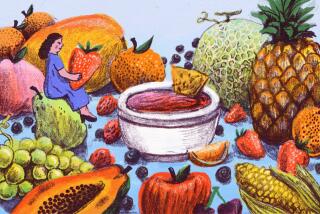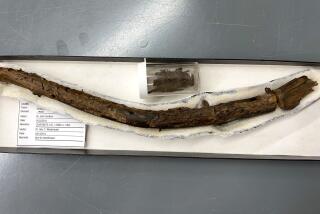Prickly Pear Proves a Very Tasty Offering
- Share via
Whether the year has been rainy or dry, the Cactus Pear can be counted on to sprout from the familiar green, Ping-Pong shaped pads of the Opuntia ficus-indica. The fruit, which goes by the name of Cactus Apple, Prickly Pear, Barbary or Indian Fig, is better known in Mexico as “tuna.”
Brilliant flowers appear in late spring and early summer before the prickly, pear-shaped fruit forms. The cactus itself is used as a landscape plant throughout the Southwestern United States, but the fruit is considered a delicacy in many areas of the world.
And in countries such as Mexico, not only is the fruit popular, but so are the tender green pads, of cladodes which Mexicans call nopales .
A scalloped edge of prickly-pears rings the Excelsior Nursery in Vista, pads abloom in delicate pink and yellow flowers. Says owner Stephen Anthony, who has been growing cactus and succulents for over a decade: “These drought tolerant plants conserve on energy and water. They’ve been around for a long time, but none took them seriously until the drought hit.”
“Cactus pear is the ultimate drought-tolerant, edible landscape plant,” concurs David Sharmahd, a local landscape designer who specializes in edible plantings. He is quick to add, however, that among the 50-plus varieties of cactus pears at Excelsior, not all are suitable for human consumption. Among his favorites are the Luther Burbank, and the Yellow Spineless which yields a yellow-fleshed fruit with a honeydew melon flavor.
Brandon Bullard, who manages the Desert Gardens II nursery in Vista, also stresses the low-maintenance aspect of the cactus. At the aptly-named nursery, rows of fruit-bearing cacti stand at attention in the sandy soil, some bearing spiny, pear-shaped or mango-like cactus fruit.
The fruit takes on many flavors, as Vista resident Stephen Faggiola, author of “Cornucopia, A Source Book of Edible Plants,” describes in his extensive compendium. The Neocardenasia herzogiana, for instance, offers a flavor similar to a blend of pineapple and strawberry.
Mario Cefalo, owner of the Solunto Bakery in downtown San Diego, also raises cactus pear commercially on his ranch in Ramona.
“A friend used to bring me cactus pears during the season. When he stopped bringing them, I decided to grow my own,” says Cefalo. His original planting of cactus pears has multiplied into several acres of fruit-bearing plants, which he now ships regularly to the East Coast.
“I like to eat them fresh,” he says, explaining that cactus pears are an important crop in his native Sicily. His fruit is generally available from late July through September, with a second planting ripening in January. “Nopales” and “tunas” are sold at the bakery and from the ranch.
Alan White, sales representative for Cal Net, a produce brokerage firm in Oceanside, ships Cefalo’s “tunas” mainly to the East Coast.
“East Coast markets are always looking for something different to sell,” he says. “In California, the consumer has so many choices that cactus pears aren’t that popular. Here they grow wild, which also detracts from going to a store and buying them, and people can go out and pick their own.”
To prepare “nopales,” according to Sharmahd, choose tender, young cactus pads, which have fewer spines than older ones. “Scale them just like you would a fish,” he recommends, placing your fingers in between the spines.
Then dice the pads, blanch them in boiling water and drain them, he says. The process gets rid of the mucilaginous material which forms when the fruit is cut up. To cut open a cactus pear, slice off the ends of the fruit. Slice the skin down through the middle and simply peel it off.
Diced nopales are referred to in Mexico as nopalitos . They are often found ready-peeled and diced in ethnic or farmer’s markets. When cooked, nopalitos taste a little like green beans, or fleshy asparagus tips. They are often mixed with salsa to make a salad or a dip. Other uses for the low-calorie cactus pear include juice, jams, syrup, or preserves.
The maximum shelf-life for the refrigerated fruit is 8 or 9 days.
SOME CACTUS PEAR SOURCES
Excelsior Cactus and Succulent Gardens, 2360 Foothill Drive, Vista. 724-2866. Wholesale to the trade only. Supplies Nurseryland. Willing to give advice over the phone.
Desert Gardens Nursery II, 800 Sunset Drive, Vista. 940-8080. Wholesale to the trade and some retail.
Mario Cefalo, Frutteto Solunto, 1760 Keys Road, Ramona. 789-9528. Also at Solunto Bakery, 1643 India St., San Diego, 233-0595. Wholesale and retail. Sells from the ranch or at the bakery. Cactus Pears from 39 cents apiece depending on size; also available by the pound depending on quantity.
Cal Net, 303 Via Del Monte, Oceanside. 722-4644. Produce broker, distributes to local supermarkets.
Dennis Sharmahd, consultant in edible landscaping design. 749-0793.
Cornucopia, A Source Book of Edible Plants , by Stephen Faggiola. Kampomg Publications, 1870 Sunrise Drive, Vista, CA 92084. Lists over 3,000 edible species of food plants. $35 plus $2.75 shipping.






